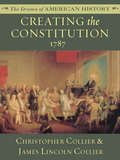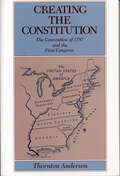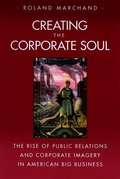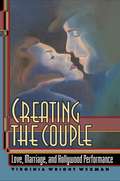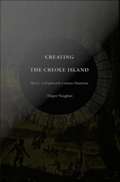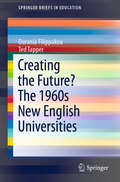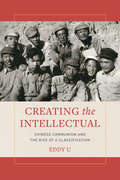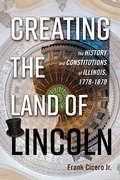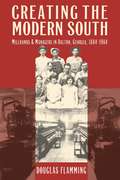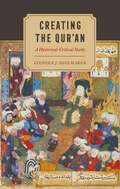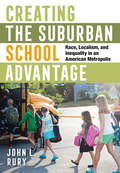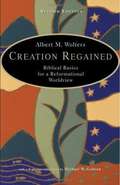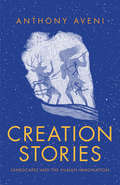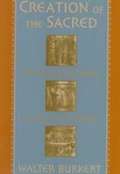- Table View
- List View
Creating the Constitution: 1787
by James Lincoln Collier Christopher CollierHistory is dramatic -- and the renowned, award-winning authors Christopher Collier and James Lincoln Collier demonstrate this in a compelling series aimed at young readers. Covering American history from the founding of Jamestown through present day, these volumes explore far beyond the dates and events of a historical chronicle to present a moving illumination of the ideas, opinions, attitudes and tribulations that led to the birth of this great nation. Using a narrative format, Creating the Constitution details the events leading up to the writing of the U.S. Constitution and what American leaders went through to create it. The authors describe the conflicts between the new states and the delegates each sent to the Constitutional Convention, as well as the work that was done to resolve the many issues at hand. The text is enhanced with images of historical art & artifacts, maps, and photographs of historic and thematic significance.
Creating the Constitution: The Convention of 1787 and the First Congress (G - Reference, Information and Interdisciplinary Subjects)
by Thornton AndersonCreating the Constitution presents a different interpretation of the Convention and the First Congress, derived largely from a close reading of Farrand's Records and the Annals of Congress. Among its special features are a critical perspective on the Framers, an examination of Court Whig influence on the Federalists, the identification of a third group—the state Federalists—between the nationalists and states' righters, and a view of the First Congress as distorting the aims of the Convention.
Creating the Corporate Soul: The Rise of Public Relations and Corporate Imagery in American Big Business
by Roland MarchandMarchand discusses how some companies came to recognize a need to enhance their social and moral legitimacy, and how they dealt with that realization during the twentieth century.
Creating the Couple: Love, Marriage, and Hollywood Performance
by Virginia Wexman WexmanWho decides how, when, and where Americans fall in love and get married? Virginia Wexman's acute observations about movie stars and acting techniques show that Hollywood has often had the most powerful voice in demonstrating socially sanctioned ways of becoming a couple. Until now serious film critics have paid little attention to the impact of performance styles on American romance, and have often treated "patriarchy," "sexuality," and the "couple" as monolithic and unproblematic concepts. Wexman, however, shows how these notions have been periodically transformed in close association with the appearance, behavior, and persona of the stars of films such as The Maltese Falcon, The Big Sleep, Way Down East, The Man Who Shot Liberty Valance, Sunset Boulevard, On the Waterfront, Nashville, House of Games, and Do the Right Thing. The author focuses first on the way in which traditional marriage norms relate to authorship (the Griffith-Gish collaboration) and genre (John Wayne and the Western). Looking at male and female stardom in terms of the development of "companionate marriage," she discusses the love goddess and the impact of method acting on Hollywood's ideals of maleness. Finally she considers the recent breakdown of the ideal of monogamous marriage in relation to Hollywood's experimentation with self-reflexive acting styles. Creating the Couple is must reading for film scholars and enthusiasts, and it will fascinate everyone interested in the changing relationships of men and women in modern culture.
Creating the Creole Island: Slavery in Eighteenth-Century Mauritius
by Megan VaughanThe island of Mauritius lies in the middle of the Indian Ocean, about 550 miles east of Madagascar. Uninhabited until the arrival of colonists in the late sixteenth century, Mauritius was subsequently populated by many different peoples as successive waves of colonizers and slaves arrived at its shores. The French ruled the island from the early eighteenth century until the early nineteenth. Throughout the 1700s, ships brought men and women from France to build the colonial population and from Africa and India as slaves. In Creating the Creole Island, the distinguished historian Megan Vaughan traces the complex and contradictory social relations that developed on Mauritius under French colonial rule, paying particular attention to questions of subjectivity and agency. Combining archival research with an engaging literary style, Vaughan juxtaposes extensive analysis of court records with examinations of the logs of slave ships and of colonial correspondence and travel accounts. The result is a close reading of life on the island, power relations, colonialism, and the process of cultural creolization. Vaughan brings to light complexities of language, sexuality, and reproduction as well as the impact of the French Revolution. Illuminating a crucial period in the history of Mauritius, Creating the Creole Island is a major contribution to the historiography of slavery, colonialism, and creolization across the Indian Ocean.
Creating the Future: Art and Los Angeles in the 1970s
by Michael FallonConceived as a challenge to long-standing conventional wisdom, Creating the Future is a work of social history/cultural criticism that examines the premise that the progress of art in Los Angeles ceased during the 1970s--after the decline of the Ferus Gallery, the scattering of its stable of artists (Robert Irwin, Ed Kienholz, Ed Moses, Ed Rusha and others), and the economic struggles throughout the decade--and didn't resume until sometime around 1984 when Mark Tansey, Alison Saar, Judy Fiskin, Carrie Mae Weems, David Salle, Manuel Ocampo, among others became stars in an exploding art market. However, this is far from the reality of the L.A. art scene in the 1970s.The passing of those fashionable 1960s-era icons, in fact, allowed the development of a chaotic array of outlandish and independent voices, marginalized communities, and energetic, sometimes bizarre visions that thrived during the stagnant 1970s. Fallon's narrative describes and celebrates, through twelve thematically arranged chapters, the wide range of intriguing artists and the world--not just the objects--they created. He reveals the deeper, more culturally dynamic truth about a significant moment in American art history, presenting an alternative story of stubborn creativity in the face of widespread ignorance and misapprehension among the art cognoscenti, who dismissed the 1970s in Los Angeles as a time of dissipation and decline.Coming into being right before their eyes was an ardent local feminist art movement, which had lasting influence on the direction of art across the nation; an emerging Chicano Art movement, spreading Chicano murals across Los Angeles and to other major cities; a new and more modern vision for the role and look of public art; a slow consolidation of local street sensibilities, car fetishism, gang and punk aesthetics into the earliest version of what would later become the "Lowbrow" art movement; the subversive co-opting, in full view of Pop Art, of the values, aesthetics, and imagery of Tinseltown by a number of young and innovative local artists who would go on to greater national renown; and a number of independent voices who, lacking the support structures of an art movement or artist cohort, pursued their brilliant artistic visions in near-isolation.Despite the lack of attention, these artists would later reemerge as visionary signposts to many later trends in art. Their work would prove more interesting, more lastingly influential, and vastly more important than ever imagined or expected by those who saw it or even by those who created it in 1970's Los Angeles. Creating the Future is a visionary work that seeks to recapture this important decade and its influence on today's generation of artists.
Creating the Future? The 1960s New English Universities (SpringerBriefs in Education)
by Ted Tapper Ourania FilippakouThis book examines the developments of the UK Higher Education system, from a time of donnish dominion, progressive decline and the increasing role of the market via the introduction of tuition fees. It offers a protracted empirical analysis of the seven new English universities of the 1960s: the Universities of East Anglia, Essex, Kent, Lancaster, Sussex, Warwick and York. It explores the creation of these universities and investigates how they each responded to a number of centrally-imposed initiatives for change in UK higher education that have emerged since their foundation. It discusses changes in system governance and how the Higher Education policies it generated have impacted upon a particular segment of the English university model. Divided into three parts, the book first deals with such topics as the control the University Grants’ Committee exercised in its heyday and how they initiated the launch of new universities. It then examines policy initiatives on government cuts on grants, research assessment exercises, quality assurance procedures and student tuition fees. The last part takes a broader approach to change by studying the significance and demise of Mission Groups, a changing system of Higher Education and more general changes regarding the state, the market and governance.
Creating the Hudson River Park: Environmental and Community Activism, Politics, and Greed
by Tom FoxThe 4-mile-long, 550-acre Hudson River Park is nearing completion and is the largest park built in Manhattan since Central Park opened more than 150 years ago. It has transformed a derelict waterfront, protected the Hudson River estuary, preserved commercial maritime activities, created new recreational opportunities for millions of New Yorkers, enhanced tourism, stimulated redevelopment in adjacent neighborhoods, and set a precedent for waterfront redevelopment. The Park attracts seventeen million visitors annually. Creating the Hudson River Park is a first-person story of how this park came to be. Working together over three decades, community groups, civic and environmental organizations, labor, the real estate and business community, government agencies, and elected officials won a historic victory for environmental preservation, the use and enjoyment of the Hudson River, and urban redevelopment. However, the park is also the embodiment of a troubling trend toward the commercialization of America’s public parks. After the defeat of the $2.4 billion Westway plan to fill 234 acres of the Hudson in 1985, the stage was set for the revitalization of Manhattan’s West Side waterfront. Between 1986 and 1998 the process focused on the basics like designing an appropriate roadway, removing noncompliant municipal and commercial activities from the waterfront, implementing temporary improvements, developing the Park’s first revenue-producing commercial area at Chelsea Piers, completing the public planning and environmental review processes, and negotiating the 1998 Hudson River Park Act that officially created the Park. From 1999 to 2009 planning and construction were funded with public money and focused on creating active and passive recreation opportunities on the Tribeca, Greenwich Village, Chelsea, and Hell’s Kitchen waterfronts. However, initial recommendations to secure long term financial support for the Park from the increase in adjacent real estate values that resulted from the Park’s creation were ignored. City and state politicians had other priorities and public funding for the Park dwindled. The recent phase of the project, from 2010 to 2021, focused on “development” both in and adjacent to the Park. Changes in leadership, and new challenges provide an opportunity to return to a transparent public planning process and complete the redevelopment of the waterfront for the remainder of the 21st-century. Fox’s first-person perspective helps to document the history of the Hudson River Park, recognizes those who made it happen and those who made it difficult, and provides lessons that may help private citizens and public servants expand and protect the public parks and natural systems that are so critical to urban well-being.
Creating the Intellectual: Chinese Communism and the Rise of a Classification
by Eddy UA free ebook version of this title is available through Luminos, University of California Press’s Open Access publishing program. Visit www.luminosoa.org to learn more.Creating the Intellectual redefines how we understand relations between intellectuals and the Chinese socialist revolution of the last century. Under the Chinese Communist Party, “the intellectual” was first and foremost a widening classification of individuals based on Marxist thought. The party turned revolutionaries and otherwise ordinary people into subjects identified as usable but untrustworthy intellectuals, an identification that profoundly affected patterns of domination, interaction, and rupture within the revolutionary enterprise. Drawing on a wide range of data, Eddy U takes the reader on a journey that examines political discourses, revolutionary strategies, rural activities, urban registrations, workplace arrangements, organized protests, and theater productions. He lays out in colorful detail the formation of new identities, forms of organization, and associations in Chinese society. The outcome is a compelling picture of the mutual constitution of the intellectual and the Chinese socialist revolution, the legacy of which still affects ways of seeing, thinking, acting, and feeling in what is now a globalized China.
Creating the Jazz Solo: Louis Armstrong and Barbershop Harmony (American Made Music Series)
by Vic HobsonThroughout his life, Louis Armstrong tried to explain how singing with a barbershop quartet on the streets of New Orleans was foundational to his musicianship. Until now, there has been no in-depth inquiry into what he meant when he said, “I figure singing and playing is the same,” or, “Singing was more into my blood than the trumpet.” Creating the Jazz Solo: Louis Armstrong and Barbershop Harmony shows that Armstrong understood exactly the relationship between what he sang and what he played, and that he meant these comments to be taken literally: he was singing through his horn.To describe the relationship between what Armstrong sang and played, author Vic Hobson discusses elements of music theory with a style accessible even to readers with little or no musical background. Jazz is a music that is often performed by people with limited formal musical education. Armstrong did not analyze what he played in theoretical terms. Instead, he thought about it in terms of the voices in a barbershop quartet.Understanding how Armstrong, and other pioneer jazz musicians of his generation, learned to play jazz and how he used his background of singing in a quartet to develop the jazz solo has fundamental implications for the teaching of jazz history and performance today. This assertive book provides an approachable foundation for current musicians to unlock the magic and understand jazz the Louis Armstrong way.
Creating the Land of Lincoln: The History and Constitutions of Illinois, 1778-1870
by Frank Cicero Jr.In its early days, Illinois seemed destined to extend the American South. Its population of transplants lived an upland southern culture and in some cases owned slaves. Yet the nineteenth century and three constitutions recast Illinois as a crucible of northern strength and American progress. Frank Cicero Jr. provides an appealing new history of Illinois as expressed by the state's constitutions—and the lively conventions that led to each one. In Creating the Land of Lincoln, Cicero sheds light on the vital debates of delegates who, freed from electoral necessity, revealed the opinions, prejudices, sentiments, and dreams of Illinoisans at critical junctures in state history. Cicero simultaneously analyzes decisions large and small that fostered momentous social and political changes. The addition of northern land in the 1818 constitution, for instance, opened up the state to immigrant populations that reoriented Illinois to the north. Legislative abuses and rancor over free blacks influenced the 1848 document and the subsequent rise of a Republican Party that gave the nation Abraham Lincoln as its president. Cicero concludes with the 1870 constitution, revealing how its dialogues and resolutions set the state on the modern course that still endures today.
Creating the Modern Iranian Woman: Popular Culture between Two Revolutions (The Global Middle East)
by Liora Hendelman-BaavurBetween the 1963 'White Revolution' and the 1979 Iranian Revolution, the position of women in Iran experienced a number of fundamental shifts. Policies and reforms were introduced, including land, suffrage, education and dress reforms which the Pahlavi regime claimed would advance the position of women and would lead to a swift modernisation of the country. In this book, Liora Hendelman-Baavur examines these changes, looking at the interactions between global aspects of modernity and notions of identity in Iranian popular culture. By focusing on the history of Iran's popular print media, with emphasis on women's commercial magazines, Hendelman-Baavur challenges familiar western assumptions about the complexities of Iranian popular culture. Her analysis situates Iranian women's magazines within their broader economic, social, political and cultural context, demonstrating how representations of the modern woman in Iranian popular culture were influenced by the intricate nature of cultural contact and exchange between Iran and the West.
Creating the Modern South
by Douglas FlammingIn Creating the Modern South, Douglas Flamming examines one hundred years in the life of the mill and the town of Dalton, Georgia, providing a uniquely perceptive view of Dixie's social and economic transformation. "Beautifully written, it combines the rich specificity of a case study with broadly applicable synthetic conclusions.--Technology and Culture"A detailed and nuanced study of community development. . . . Creating the Modern South is an important book and will be of interest to anyone in the field of labor history.--Journal of Economic History "A rich and provocative study. . . . Its major contribution to our knowledge of the South is its careful account of the evolution and collapse of mill culture.--Journal of Southern History "Ambitious, and at times provocative, Creating the Modern South is a well-researched, highly readable, and engaging book.--Journal of American History
Creating the National Pastime: Baseball Transforms Itself, 1903-1953
by G. Edward WhiteAt a time when many baseball fans wish for the game to return to a purer past, G. Edward White shows how seemingly irrational business decisions, inspired in part by the self-interest of the owners but also by their nostalgia for the game, transformed baseball into the national pastime. Not simply a professional sport, baseball has been treated as a focus of childhood rituals and an emblem of American individuality and fair play throughout much of the twentieth century. It started out, however, as a marginal urban sport associated with drinking and gambling. White describes its progression to an almost mythic status as an idyllic game, popular among people of all ages and classes. He then recounts the owner's efforts, often supported by the legal system, to preserve this image. Baseball grew up in the midst of urban industrialization during the Progressive Era, and the emerging steel and concrete baseball parks encapsulated feelings of neighborliness and associations with the rural leisure of bygone times. According to White, these nostalgic themes, together with personal financial concerns, guided owners toward practices that in retrospect appear unfair to players and detrimental to the progress of the game. Reserve clauses, blacklisting, and limiting franchise territories, for example, were meant to keep a consistent roster of players on a team, build fan loyalty, and maintain the game's local flavor. These practices also violated anti-trust laws and significantly restricted the economic power of the players. Owners vigorously fought against innovations, ranging from the night games and radio broadcasts to the inclusion of African-American players. Nonetheless, the image of baseball as a spirited civic endeavor persisted, even in the face of outright corruption, as witnessed in the courts' leniency toward the participants in the Black Sox scandal of 1919. White's story of baseball is intertwined with changes in technology and business in America and with changing attitudes toward race and ethnicity. The time is fast approaching, he concludes, when we must consider whether baseball is still regarded as the national pastime and whether protecting its image is worth the effort.
Creating the National Security State: A History of the Law That Transformed America
by Douglas StuartFor the last sixty years, American foreign and defense policymaking has been dominated by a network of institutions created by one piece of legislation--the 1947 National Security Act. This is the definitive study of the intense political and bureaucratic struggles that surrounded the passage and initial implementation of the law. Focusing on the critical years from 1937 to 1960, Douglas Stuart shows how disputes over the lessons of Pearl Harbor and World War II informed the debates that culminated in the legislation, and how the new national security agencies were subsequently transformed by battles over missions, budgets, and influence during the early cold war. Stuart provides an in-depth account of the fight over Truman's plan for unification of the armed services, demonstrating how this dispute colored debates about institutional reform. He traces the rise of the Office of the Secretary of Defense, the transformation of the CIA, and the institutionalization of the National Security Council. He also illustrates how the development of this network of national security institutions resulted in the progressive marginalization of the State Department. Stuart concludes with some insights that will be of value to anyone interested in the current debate over institutional reform.
Creating the Nazi Marketplace
by S. Jonathan WiesenWhen the Nazis came to power in 1933, they promised to build a vibrant consumer society. But they faced a dilemma. They recognized that consolidating support for the regime required providing Germans with the products they desired. At the same time, the Nazis worried about the degrading cultural effects of mass consumption and its association with "Jewish" interests. This book examines how both the state and private companies sought to overcome this predicament. Drawing on a wide range of sources - advertisements, exhibition programs, films, consumer research, and marketing publications - the book traces the ways National Socialists attempted to create their own distinctive world of buying and selling. At the same time, it shows how corporate leaders and everyday Germans navigated what S. Jonathan Wiesen calls "the Nazi marketplace. " A groundbreaking work that combines cultural, intellectual, and business history, Creating the Nazi Marketplace offers an innovative interpretation of commerce and ideology in the Third Reich.
Creating the Qur’an: A Historical-Critical Study
by Stephen J. ShoemakerA free open access ebook is available upon publication. Learn more at www.luminosoa.org.Creating the Qur’an presents the first systematic historical-critical study of the Qur’an’s origins, drawing on methods and perspectives commonly used to study other scriptural traditions. Demonstrating in detail that the Islamic tradition relates not a single attested account of the holy text’s formation, Stephen J. Shoemaker shows how the Qur’an preserves a surprisingly diverse array of memories regarding the text’s early history and its canonization. To this he adds perspectives from radiocarbon dating of manuscripts, the linguistic history of Arabic, the social and cultural history of late ancient Arabia, and the limitations of human memory and oral transmission, as well as various peculiarities of the Qur’anic text itself. Considering all the relevant data to present the most comprehensive and convincing examination of the origin and evolution of the Qur’an available, Shoemaker concludes that the canonical text of the Qur’an was most likely produced only around the turn of the eighth century.
Creating the Suburban School Advantage: Race, Localism, and Inequality in an American Metropolis (Histories of American Education)
by John L. RuryCreating the Suburban School Advantage explains how American suburban school districts gained a competitive edge over their urban counterparts. John L. Rury provides a national overview of the process, focusing on the period between 1950 and 1980, and presents a detailed study of metropolitan Kansas City, a region representative of trends elsewhere.While big-city districts once were widely seen as superior and attracted families seeking the best educational opportunities for their children, suburban school systems grew rapidly in the post–World War II era as middle-class and more affluent families moved to those communities. As Rury relates, at the same time, economically dislocated African Americans migrated from the South to center-city neighborhoods, testing the capacity of urban institutions. As demographic trends drove this urban-suburban divide, a suburban ethos of localism contributed to the socioeconomic exclusion that became a hallmark of outlying school systems. School districts located wholly or partly within the municipal boundaries of Kansas City, Missouri, make for revealing cases that illuminate our understanding of these national patterns.As Rury demonstrates, struggles to achieve greater educational equity and desegregation in urban centers contributed to so-called white flight and what Senator Daniel Patrick Moynihan considered to be a crisis of urban education in 1965. Despite the often valiant efforts made to serve inner city children and bolster urban school districts, this exodus, Rury cogently argues, created a new metropolitan educational hierarchy—a mirror image of the urban-centric model that had prevailed before World War II. The stubborn perception that suburban schools are superior, based on test scores and budgets, has persisted into the twenty-first century and instantiates today's metropolitan landscape of social, economic, and educational inequality.
Creation
by Gore VidalThe incomparable Gore Vidal interprets and animates history--this time in a panoramic tour of the 5th century B.C.--and embellishes it with his own ironic humor, brilliant insights and piercing observations.
Creation Myths of America
by Jeremiah CurtinThis book was written in 1895 and is a collection of creation myths of the Wintu and Yana peoples of northern California.
Creation Regained: Biblical Basics for a Reformational Worldview
by Michael W. Goheen Albert M. WoltersIn this brief and straightforward examination of Christians' basic beliefs, Albert M. Wolters spells out the structure of a reformational worldview and its significance for those who seek to follow the Scriptures. Wolters begins by defining the nature and scope of a worldview, distinguishing it from philosophy or theology, and noting that the Christian community has advanced a variety of worldviews. He then outlines a Reformed analysis of the three fundamental turning points in human history -- Creation, the Fall, and Redemption -- concluding that while the Fall might reach into every corner of the world, Christians are called to participate in Christ's redemption of all creation.
Creation Stories: Landscapes and the Human Imagination
by Anthony AveniAn accessible exploration of how diverse cultures have explained humanity&’s origins through narratives about the natural environment Drawing from a vast array of creation myths—Babylonian, Greek, Aztec, Maya, Inca, Chinese, Hindu, Navajo, Polynesian, African, Norse, Inuit, and more—this concise illustrated book uncovers both the similarities and differences in our attempts to explain the universe. Anthony Aveni, an award-winning author and professor of astronomy and anthropology, examines the ways various cultures around the world have attempted to explain our origins, and what roles the natural environment plays in shaping these narratives. The book also celebrates the audacity of the human imagination. Whether the first humans emerged from a cave, as in the Inca myths, or from bamboo stems, as the Bantu people of Africa believed, or whether the universe is simply the result of Vishnu&’s cyclical inhales and exhales, each of these fascinating stories reflects a deeper understanding of the culture it arose from as well as its place in the larger human narrative.
Creation of the Sacred: Tracks of Biology in Early Religions
by Walter BurkertHow mythology is generated.
Creation of the Sacred: Tracks of Biology in Early Religions
by Walter BurkertSacrifice—ranging from the sacrifice of virgins to circumcision to giving up what is most valued—is essential to all religions. Could there be a natural, even biological, reason for these practices? Something that might explain why religions of so many different cultures share so many rituals and concepts? In this extraordinary book, one of the world’s leading authorities on ancient religions explores the possibility of natural religion—a religious sense and practice naturally proceeding from biological imperatives. Because they lack later refinements, the earliest religions from the Near East, Israel, Greece, and Rome may tell us a great deal about the basic properties and dynamics of religion, and it is to these cultures that Walter Burkert looks for answers. His book takes us on an intellectual adventure that begins some 5,000 years ago and plunges us into a fascinating world of divine signs and omens, offerings and sacrifices, rituals and beliefs unmitigated by modern science and sophistication. Tracing parallels between animal behavior and human religious activity, Burkert suggests natural foundations for sacrifices and rituals of escape, for the concept of guilt and punishment, for the practice of gift exchange and the notion of a cosmic hierarchy, and for the development of a system of signs for negotiating with an uncertain environment. Again and again, he returns to the present to remind us that, for all our worldliness, we are not so far removed from the first Homo religiosus. A breathtaking journey, as entertaining as it is provocative, Creation of the Sacred brings rich new insight on religious thought past and present and raises serious questions about the ultimate reasons for, and the ultimate meaning of, human religiousness.
Creation: A Novel
by Katherine GovierA New York Times Notable book about Audubon&’s voyage to capture Birds of America is a &“brilliantly insightful and ravishingly sensuous tale of adventure.&” (Booklist) In this atmospheric and enthralling novel, Katherine Govier tells the story of the world's greatest living bird artist as he finally understands the paradox embedded in his art: that the act of creation is also an act of destruction. Running two steps ahead of the bailiff, alternately praised and reviled, John James Audubon set himself the audacious task of drawing, from nature, every bird in North America. The result was his masterpiece, The Birds of America. In June 1833, partway through his mission, he enlisted his son, Captain Bayfield of the Royal Navy, and a party of young gentlemen to set sail for nesting grounds no ornithologist had ever seen, in the treacherous passage between Newfoundland and Labrador. Creation explores the short, stormy summer throughout which the captain became the artist's foil, measuring stick, and the recipient of his long-held secrets. It is an exploration of that fateful expedition, a probing and imaginative narrative that fills in a gap in the visionary naturalist's well-documented life. &“Carefully crafted and deeply thoughtful.&” —Kirkus Reviews
